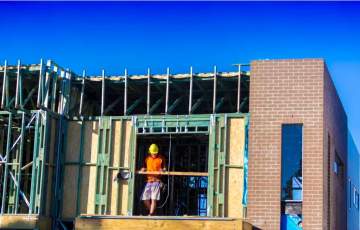
It is estimated that between 40-60 percent of energy usage in buildings is due to climate control, including air conditioning and heating, in order to maintain comfortable conditions indoors.
For both individuals and businesses, this wastage needs to be reduced – not only as a sound ecological choice, but an economical one too.
‘Smart materials’ are materials that are engineered to have specific functions like blocking harmful ultraviolet (UV) radiation and heat regulation.
These materials are being researched as part of a comprehensive energy solution for the future, in order to limit energy loss across all seasons and climate conditions.
The greatest obstacles facing the widespread use of smart materials are the high temperatures and extreme conditions required to produce them. This makes synthesis difficult to undertake, and until now has often prevented the incorporation of smart materials into new and existing buildings.
Thermochromic vanadium dioxide (VO₂) has some unusual properties that make it an ideal candidate for use as a smart material.
When heated, its optical transmission, or light filtering and electrical properties undergo a dramatic transition, and at higher temperatures, it changes to a state that can block heat, infrared (IR), and UV radiation.
This transition allows VO₂ to self-regulate, adapting to different environmental temperatures passively and automatically.
Thermochromic VO₂ is well-suited for various uses, including smart, energy-saving windows, optoelectronics, memory devices, and adaptive radiative heating/cooling management. At high temperatures thermochromic vanadium dioxide changes to a state that can block heat, infrared (IR), and UV radiation.
However, its synthesis has been a long-standing challenge, requiring specialized substrates with particular plane orientations, high temperatures of up to 600 ºC, and high vacuums.
In recent years, thin coatings of VO₂ have been a subject of extensive research with the hope of retrofitting existing materials or to incorporate it into any material for energy and UV regulation.

However, these coatings aren’t compatible with all glass types, plastics, and structures, and cannot be incorporated into existing structures without the cost of rebuilding.
Our new research demonstrates an innovative method to synthesize VO₂ in solution. This solution can be applied and then evaporated at room temperature, overcoming the hurdle of high processing temperatures.
Because some materials, like soda-lime glass and plastics, cannot be heated to the temperatures required for current methods this new process addresses the challenge of temperature-sensitive surfaces so that the material can be applied on any surface, including existing infrastructure.
Some materials, like glass and plastics, cannot be heated to the temperatures required to retrofit for energy and UV regulation.
This is done by dividing the challenge into two components: synthesis of the ‘smart material’ and its incorporation into an easy-to-evaporate solvent.
The ‘smart material’ is bonded to a growth surface with an intrinsic electric charge. The charge interactions between the surface and solvent then allow the material to be delaminated and converted into microstructures, in solution form.
By optimizing this ‘smart material’ into a solution that can be applied at room temperature, it is no longer necessary to expose surfaces used for synthesis to the extreme conditions previously required.
The research suggests that the solution can be applied to all surfaces that are environment-facing, and can alter these surfaces to provide UV blocking and heat reduction properties.
The current prototype shows a significant reduction in heat radiation. For example, when the temperature is 30 and 40ºC the surface records 19 and 20ºC, respectively.
This reduction in heat radiation would responsively and automatically make hot conditions more comfortable without unnecessary wastage in energy expenditure.

This emerging field of smart building construction seeks to apply smart materials before, during, and after the construction of buildings.
Importantly, this work also provides a new way of thinking about adapting smart materials into pre-existing infrastructure.
In the past, retrofitting new materials into existing structures was not always a consideration. However, this is one of the core problems in attempting to create healthier and more sustainable energy pathways for the future.
Often, it isn’t possible to dismantle current structures in order to make them more energy-efficient, without incurring high costs that make environmentally-sound options less achievable.
However, this research offers a different pathway forward, on how to improve the structures we already have, without further costs and more negative impacts on the environment.
This means that in the emerging field of smart building construction, we can apply smart materials before, during, and after the construction of buildings.
An important consideration in the research is to develop solutions for saving energy in rural areas around the world, which have limited access to energy. Structures in remote areas will benefit greatly from passive (non-mechanical) climate control, improving living conditions greatly.
With climate change and climate control being environmentally, economically, and socially complex challenges, engineering new materials are paramount.
The research also has far-reaching potential applications in other fields that use functional smart materials, like electronics, biosensors, communication devices, and memory devices.
Overcoming the long-standing challenge of applying smart materials to temperature-sensitive flexible surfaces could also give rise to the next generation of new flexible electronics like electronic fabrics, plastic patches, and printed electronics.
Developing research solutions to energy problems depends on being able to integrate new discoveries into current systems. Smart materials are an important step in this direction, and they have the potential to transform how we harness the energy and limit waste in the future.
This work is a collaborative effort between the Department of Electrical and Electronic Engineering in the School of Engineering at the University of Melbourne and the technical assistance of staff at Melbourne Centre for Nanofabrication, RMIT Microscopy and Microanalysis facility, the Ian Potter NanoBioSensing facility, and the MicroNano Research facility at RMIT University.

This Post Has 0 Comments